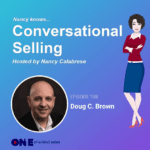Lead Generation is a Sales Cycle All Unto Itself

Sales leaders often have unrealistic expectations for their cold calling campaigns. They expect appointments will materialize quickly. They can lose patience, get frustrated, and consider the whole process a waste of time when this doesn’t happen. However, meaningful lead generation, where you are producing appointments with leads that are interested in what you have to offer, doesn’t happen overnight.
Generally, it takes 8-12 touches with C-suite executives before they pay attention! Then it’s a timing issue. Do they require your services at the time of the first conversation?
There’s more to cold calling than getting the appointment. Here’s what is involved in a meaningful cold calling campaign:
List Clean-up – When you begin calling you will find that some list clean-up will be necessary. This includes weeding out companies that are not a good match, as well as updating names, emails and telephone numbers.
Getting to Know You – Keep in mind that your leads don’t know you. Each time you make contact, you are establishing rapport and building a quality relationship.
Collecting Intel – As you make calls you are probing the prospect and collecting information about the company and the challenges that they are facing. This information becomes invaluable in relationship building and certainly in the proposal and closing stages of the sale.
Awareness – While you have learned a lot about the prospect and built rapport with them, the prospect may not be experiencing the pain that is required to make a purchase at that time. If there is no need, there is no sale. But with regular contact over an extended period of time, you will be top of mind when there is a need.
Recycle – It takes several touches before the decision maker is paying attention but it’s a delicate balance between staying in front of prospects and not becoming a nuisance. You start by working your list over a 4-week period. After some time without contact, the list is worked again. We recommend the entire process is repeated three times a year.
You can see how lead generation could be considered a sales cycle all unto itself. Impatience is quickly dismissed when the quality of the leads and appointments is realized.


 Cold calling is an opportunity to probe, build rapport and set the foundation for a long-term relationship. This involves improvising, asking probing questions and reacting to what the prospect is saying. That said, you still need to start with a script. While you don’t want to read it, you do want to use your script to prepare for the call.
Cold calling is an opportunity to probe, build rapport and set the foundation for a long-term relationship. This involves improvising, asking probing questions and reacting to what the prospect is saying. That said, you still need to start with a script. While you don’t want to read it, you do want to use your script to prepare for the call. In networking, a handshake is used to introduce yourself. It conveys a willingness to engage with someone that we don’t know or don’t know well. In the course of networking, we’ve all shaken a countless number of hands. Sometimes it leads to business relationships, but more often than not, it doesn’t.
In networking, a handshake is used to introduce yourself. It conveys a willingness to engage with someone that we don’t know or don’t know well. In the course of networking, we’ve all shaken a countless number of hands. Sometimes it leads to business relationships, but more often than not, it doesn’t. If you are looking for growth, (and who isn’t), it’s a good idea to pay more attention to Presales. Presales is key in obtaining, winning and keeping customers. You may not feel this way now but you’ll change your mind when you have a better understanding of what the Presales Process is and what it delivers.
If you are looking for growth, (and who isn’t), it’s a good idea to pay more attention to Presales. Presales is key in obtaining, winning and keeping customers. You may not feel this way now but you’ll change your mind when you have a better understanding of what the Presales Process is and what it delivers.

